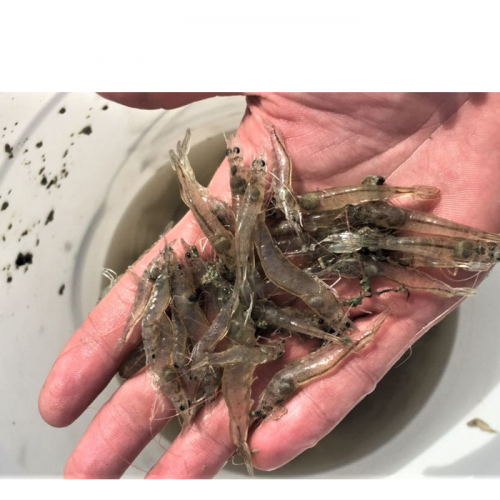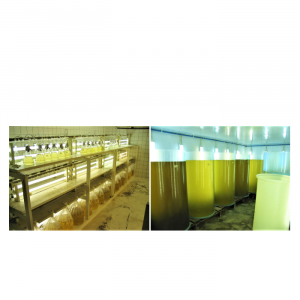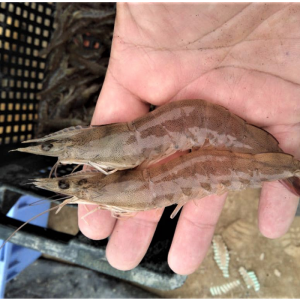
Pacific White Shrimp Responses to Low Salinity Temperature Fluctuations
| Mon, 04 Jan 2021 - 10:52

The Pacific white shrimp ( Litopenaeus vannamei ), with its wide range of tolerance to salinity, rapid growth and several other characteristics appropriate for intensive aquaculture, has become the most important cultured shrimp species in the world. However, a variety of environmental factors can affect shrimp growth, such as changes in pH, salinity, dissolved oxygen (DO), temperature, and also chemical compounds such as nitrite, ammonia, and sulfur.
The annual cold wave affecting the shrimp industry in southern China during the winter months (November to January) causes significant economic losses to the L. vannamei aquaculture industry . However, little information is available on the physiological responses of shrimp during the process of gradual cooling and warming of temperature.
For shrimp, researchers have reported on the histology [the study of the microscopic anatomy of tissues and cells from animals and plants] of their hepatopancreas as a tool to monitor the impact of environmental stressors that can cause ultrastructural alterations at the onset of stress. . For example, environmental stresses such as changes in pH can cause changes or damage to the cells of the hepatopancreas. However, for temperature fluctuations, so far there is no definitive information on any changes in the hepatopancreas.
This article, adapted and summarized from the original publication (Wang, Z. et al. 2019. Physiological Responses of Pacific White Shrimp Litopenaeus vannamei to Temperature Fluctuation in Low-Salinity Water. Front. Physiol., August 13, 2019) - reports on a study that investigated various physiological responses in juvenile L. vannamei subjected to temperature fluctuations (28 to 13 to 28 degrees-C) in low salinity water.
Also read: Supplementing Rotifers to Reduce Stress for White Shrimp
Study setup
Juveniles of L. vannamei (average weight 5.4 ± 0.7 grams) from a commercial farm in Panyu (Guangdong, China) were transported to the laboratory and acclimatized in tanks of filtered and aerated seawater for several days before the experiment. During the acclimatization stage, the salinity of the water and the temperature in the tanks were consistent with those of the farm's culture ponds (salinity 5 ppt, pH 8.3 ± 0.1 and temperature 28 ± 1 degrees-C) where the prawns. The shrimp were fed commercial feed twice a day at 5 percent of their body weight.
From these shrimp, the selected healthy individuals were randomly divided into three replicate tanks and placed in an artificial climate incubator. The water temperature was reduced from the acclimatization temperature (AT, 28 degrees-C) to 13 degrees-C with a cooling rate of 7.5 degrees-C per day (2.5 degrees-C every 8 hours). After 13 degrees-C for 24 hours, the water temperature was increased back to 28 degrees-C at the same rate.
At various temperature points (28, 23, 18, 13 and 13 degrees-C for 24 hours during the cooling process and at 18 and 28 degrees-C during the heating process), whole hepatopancreas from experimental animals were dissected and preserved. for several hours. analysis.
For detailed information on experimental design and animal husbandry; collection and preservation of tissue samples; histology, RNA and DNA extractions, real-time polymerase chain reaction (qPCR) and other tests; and statistical analysis, see the original publication.
Also read: Transcriptomic Analysis of Pacific White Shrimp in Response to AHPND
Results and Discussion
In this study, we investigated various physiological responses, including histological changes in the hepatopancreas, concentrations of plasma metabolites, expression of various genes, and other processes, in juvenile L. vannamei exposed to fluctuations in water temperature (28 to 13 to 28 degrees-C). All these responses and processes were affected as temperatures decreased, but in general they recovered during the reheating stage and showed that L. vannamei shrimp can adapt to a certain level of temperature fluctuations.
The crustacean hepatopancreas is a vital organ involved in excretion, molting, various metabolic activities, and storage of energy reserves. The results of our study showed that the number and volume of certain cells (B cells) in the tubules of the hepatopancreas increased significantly after the shrimp underwent cold stress. This may be related to the fact that B cells are the main site of absorption and digestion of nutrients. It is possible that the high rate of synthesis and release of digestive enzymes in B cells accelerated the mobilization of nutrients in the tubules of the hepatopancreas, which would help the shrimp better adapt to temperature stress.
In shrimp, the hepatopancreas is known to have a high self-healing capacity. For example, researchers have reported that L. vannamei can repair hepatopancreas lesions after prolonged exposure to low zinc levels and low pH. And that the weight of the hepatopancreas of L. vannamei decreased significantly after fasting, but then increased immediately after the animals began to feed again. In our study, the histological damage of the hepatopancreas was reversed after the animals returned to higher water temperatures, confirming this reported capacity for self-repair.
Also read: Evaluating Plant Protein Sources Replacing Fishmeal In Juvenile White Shrimp Diets
Regarding changes in shrimp plasma [liquid portion in shrimp blood, the hemolymph] during temperature fluctuations, our results showed that lipids and proteins in L. vannamei plasma responded more quickly to fluctuation temperature, while glucose levels were stable before the temperature of the experimental water reached 13 degrees-C, and it recovered to acclimatization levels after the temperature rose again to 28 degrees-C.
The hepatopancreas is typically lipid-rich and appears to be the primary site for gluconeogenesis [a metabolic pathway that generates glucose from certain non-carbohydrate carbon substrates] in decapod crustaceans, those with five pairs of walking legs, such as prawns. Therefore, combined with our observed hepatopancreas histology and plasma results, we conclude that the increase in B cells in the hepatopancreas facilitates gluconeogenesis to synthesize glucose from proteins and lipids, through which shrimp supply the demand for glucose under experimental cold stress. However, after the water temperature dropped to 13 degrees-C, the rupture of the tubules of the hepatopancreas causes lipids and proteins to enter the hemolymph,
Non-specific immunity plays an important role in the immune defense of aquatic animals. Shrimp like L. vannamei rely entirely on cellular and humoral immunity to prevent external injury. The enzyme alkaline phosphatase (ALT) is directly involved in several metabolic pathways and plays an important role in the immune system of shrimp against various pathogens, probably because it can help protect the hepatopancreas and hemolymph from damage caused by cold.
Analysis of plasma metabolite concentration also showed that ALT enzyme activity reached its highest level at 13 degrees-C; ALT activity in plasma is inversely proportional to the health of the hepatopancreas. This finding is consistent with previous studies and confirms the self-healing capacity of shrimp L. vannamei . Furthermore, the expressions of many genes that we evaluated in our study, as well as the number of hemocytes [type of cell involved in the invertebrate immune system], reached their highest level in the hepatopancreas at 13 degrees-C.
Also read: Effect of Streptomyces Probiotics on Gut Microbiota of Pacific White Shrimp
Perspectives
The results of our study showed that proteins and lipids were the main source of energy for L. vannamei during temperature fluctuations. During the rewarming stage, all overall assessed histopathological symptoms reversed and all plasma metabolite concentrations and gene expressions returned to acclimatization temperature levels. Overall, the results suggest that L. vannamei can adapt to a certain level of temperature fluctuation, but the detailed adaptation mechanism in this shrimp species still needs further study.






















